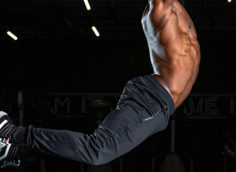Forearm pain from bench pressing is common... and it's misunderstood. The culprit is generally the brachoradialis, a muscle normally associated with hammer curls.
The reason it can get upset is because the fixed hand position on the bar forces your forearm through a pronation and supination cycle as the elbow bends and straightens.
That means you're effectively being forced to turn your hand over towards an end-range "palms down" position in the bottom of a bench press. Then, as you press up towards lockout, the forearm supinates into a more neutral position.
This happens without us really thinking about it. However, while the forearm pronates and supinates, the brachoradialis is loaded to stabilize the movement occurring between the two long bones of the forearm.
It's a little complicated, because the muscle changes functions through the movement, doing different things at different points. Small stabilizer muscles under big loads often leads to overload and pain. Yes, you can back off bench pressing for a while, or you can rub or needle the muscle. All that might make it feel better in some way, but none of it will resolve the problem.
Solving the issue requires you to condition the problem range of movement, making that range more easily available and stronger so it has the capacity to deal with the demands of benching. That means specifically conditioning loaded forearm pronation through a horizontal pressing cycle.
Sounds complex, but the hammer press is the simple answer:
Hammer Press
Hold a hammer out at arm's length and pronate the forearm until the hammer is parallel to the ground. Start with a very short lever. That means holding close to the top of the handle, near the head of the hammer.
Holding the hammer parallel to the floor, try to mimic the bench press movement. You'll feel the forearm fire up and work, and you'll feel the problem muscle in the relevant way. Some discomfort, up to around 4-5 out of 10 on the pain scale, is acceptable and therapeutic throughout the movement.
Do slow and controlled presses. If you need to make it more challenging, work your way down the hammer shaft to make the lever longer.
Because the movement goes through the same range of motion as your bench press, it's the only way to ensure you're conditioning the relevant parts of the relevant muscles/tendons so they can adapt and actually solve your problem.
Since this is a therapeutic exercise, it should be done daily and only to moderate discomfort. You're actually adding work to tissues that are failing to cope with their current workload, so go steady. It may take a week or two to adapt and improve.
It's worth the time investment though. You're really solving the problem, not just masking it.




